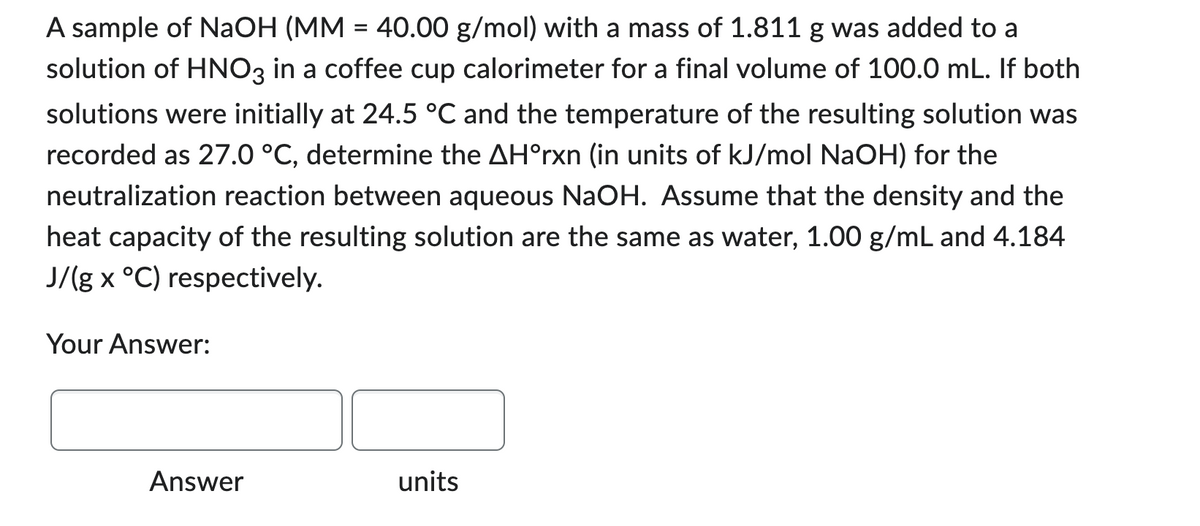A sample of NaOH (MM = 40.00 g/mol) with a mass of 1.811 g was added to a solution of HNO3 in a coffee cup calorimeter for a final volume of 100.0 mL. If both solutions were initially at 24.5 °C and the temperature of the resulting solution was recorded as 27.0 °C, determine the AH°rxn (in units of kJ/mol NaOH) for the neutralization reaction between aqueous NaOH. Assume that the density and the heat capacity of the resulting solution are the same as water, 1.00 g/mL and 4.184 J/(g x °C) respectively.
A sample of NaOH (MM = 40.00 g/mol) with a mass of 1.811 g was added to a solution of HNO3 in a coffee cup calorimeter for a final volume of 100.0 mL. If both solutions were initially at 24.5 °C and the temperature of the resulting solution was recorded as 27.0 °C, determine the AH°rxn (in units of kJ/mol NaOH) for the neutralization reaction between aqueous NaOH. Assume that the density and the heat capacity of the resulting solution are the same as water, 1.00 g/mL and 4.184 J/(g x °C) respectively.
Chemistry & Chemical Reactivity
10th Edition
ISBN:9781337399074
Author:John C. Kotz, Paul M. Treichel, John Townsend, David Treichel
Publisher:John C. Kotz, Paul M. Treichel, John Townsend, David Treichel
Chapter5: Principles Of Chemical Reactivity: Energy And Chemical Reactions
Section5.6: Calorimetry
Problem 5.7CYU: Assume 200. mL of 0.400 M HCl is mixed with 200. mL of 0.400 M NaOH in a coffee-cup calorimeter The...
Related questions
Question

Transcribed Image Text:A sample of NaOH (MM = 40.00 g/mol) with a mass of 1.811 g was added to a
solution of HNO3 in a coffee cup calorimeter for a final volume of 100.0 mL. If both
solutions were initially at 24.5 °C and the temperature of the resulting solution was
recorded as 27.0 °C, determine the AH°rxn (in units of kJ/mol NaOH) for the
neutralization reaction between aqueous NaOH. Assume that the density and the
heat capacity of the resulting solution are the same as water, 1.00 g/mL and 4.184
J/(g x °C) respectively.
Your Answer:
Answer
units
Expert Solution
This question has been solved!
Explore an expertly crafted, step-by-step solution for a thorough understanding of key concepts.
This is a popular solution!
Trending now
This is a popular solution!
Step by step
Solved in 3 steps

Knowledge Booster
Learn more about
Need a deep-dive on the concept behind this application? Look no further. Learn more about this topic, chemistry and related others by exploring similar questions and additional content below.Recommended textbooks for you

Chemistry & Chemical Reactivity
Chemistry
ISBN:
9781337399074
Author:
John C. Kotz, Paul M. Treichel, John Townsend, David Treichel
Publisher:
Cengage Learning

Chemistry: Principles and Practice
Chemistry
ISBN:
9780534420123
Author:
Daniel L. Reger, Scott R. Goode, David W. Ball, Edward Mercer
Publisher:
Cengage Learning

Chemistry
Chemistry
ISBN:
9781305957404
Author:
Steven S. Zumdahl, Susan A. Zumdahl, Donald J. DeCoste
Publisher:
Cengage Learning

Chemistry & Chemical Reactivity
Chemistry
ISBN:
9781337399074
Author:
John C. Kotz, Paul M. Treichel, John Townsend, David Treichel
Publisher:
Cengage Learning

Chemistry: Principles and Practice
Chemistry
ISBN:
9780534420123
Author:
Daniel L. Reger, Scott R. Goode, David W. Ball, Edward Mercer
Publisher:
Cengage Learning

Chemistry
Chemistry
ISBN:
9781305957404
Author:
Steven S. Zumdahl, Susan A. Zumdahl, Donald J. DeCoste
Publisher:
Cengage Learning


Chemistry: An Atoms First Approach
Chemistry
ISBN:
9781305079243
Author:
Steven S. Zumdahl, Susan A. Zumdahl
Publisher:
Cengage Learning

Chemistry for Engineering Students
Chemistry
ISBN:
9781285199023
Author:
Lawrence S. Brown, Tom Holme
Publisher:
Cengage Learning